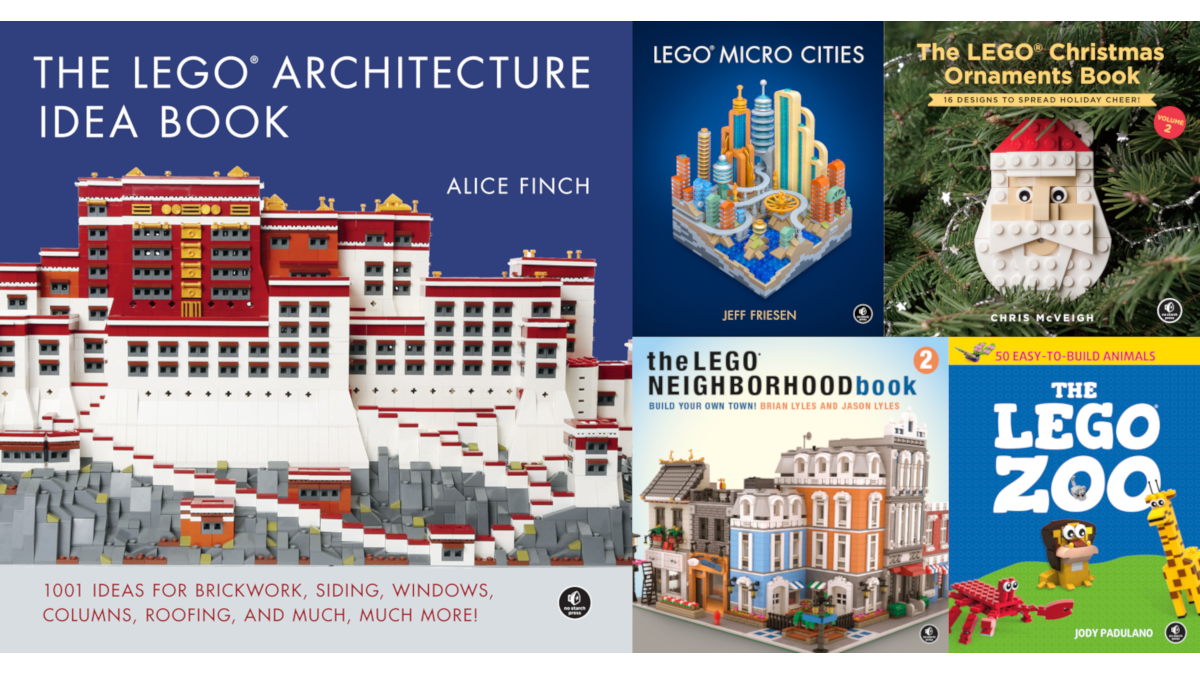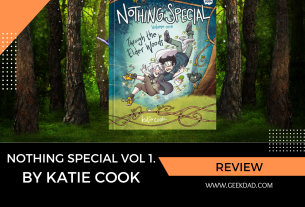
Though LEGO has a long history of making amazing toys for kids (and adults) that have gotten more and more sophisticated over the years, sometimes we still run short on ideas of what to build with our loose pieces.
Fortunately for us, No Starch Press has a solid history (becoming a long history itself) of publishing books that give us imaginative and often elaborate ideas of what to do with our random collection of bricks and other kinds of LEGO pieces. We’ve already covered many of them at the GeekDad and GeekMom blogs (links to many of the reviews can be found at the bottom of this post), but there are some new books out this fall that add some quality options to the stack. Below, I take a closer look at five of them.
LEGO Micro Cities: Build Your Own Mini Metropolis!
LEGO Micro Cities by Jeff Friesen gives you all sorts of inspiration, examples, tips, techniques, and tricks to building your own mini metropolis that you can tower over and use your favorite Godzilla figure to crush. The book begins by going over your options for bases to use and foundations to build. What kind of scene do you want to create? Is it on solid ground? Next to a river? Most of the rest of the book is filled with specific builds from the Gilded City to Steamworks to Tomorrowland settings. These sections go into specific detail about how to build what the author has dreamed up, along with variation suggestions for when you don’t have all of the listed pieces. Then the very end of the book goes through finishing touches, such as bridges, ships, and landscaping. For these designs, you can follow the instructions to the letter—which might mean ordering some special bricks online—or you can pillage your own LEGO piece collection and build your own take on the design. Each one of the builds includes plenty of images, a listing of the pieces required (including their part numbers), and step-by-step instructions. Because these designs use pretty small pieces, these builds won’t take up much room on your bookshelves.
This book is a LEGO dreamer’s dream on a very small scale and is gorgeous as well as masterfully assembled (see what I did there?).
The LEGO Christmas Ornaments Book: Volume 2
The LEGO Christmas Ornaments Book: Volume 2 by Chris McVeigh is a follow-up to the first volume of LEGO ornament-building instruction (see review link at the bottom of this post). In it, you’ll find even more ideas of holiday ornaments to build out of LEGO, each one perfectly sized for your tree or your desk. Each build includes a complete parts list (with part numbers) and step-by-step instructions for building. There’s no fluff in this book; it’s all building instructions. Deck your halls (or your tree) with ornaments such as Santa, Reindeer, Mrs. Snow, Gingerbread House, Blizzard, Fries, a ’90s PC, and even a Crane Game (or, as I like to call it since Wow! Wow! Wubbzy!, the Grabbity-Grab Game).
If you want to decorate with LEGO this year or if you want to give LEGO gifts, building a series of ornaments from this book is a great idea. They are all well done and can add to your holiday cheer.
The LEGO Architecture Idea Book: 1001 Ideas for Brickwork, Siding, Windows, Columns, Roofing, and Much, Much More!
The LEGO Architecture Idea Book by Alice Finch breaks down architectural elements, teaching you how to create different looks for brickwork, siding, curved walls, patterned walls, molding, windows, doors, columns, towers, roofs, domes, and more. Rather than have start-to-finish projects that it shows you how to build, it focuses on the specific elements, showing examples of at least a half dozen of each sub-type and what goes into them. The author even specifies the part numbers of all the components. In addition to that, the book includes many how-to sections for a closer look.
Many of the designs in this book use pieces in unconventional ways, such as croissants as molding or quarter rounds for decorative tiles. This book also has some really interesting SNOT (Studs Not on Top) techniques. I learned some approaches that I hadn’t seen before.
Whether you’re new to building freeform architectural LEGO builds or you’re an old pro who needs some fresh ideas, if you like building architectural elements of any kind, this book is a must-have for your LEGO reference library. Pardon me while I go plan my LEGO dream house…
The LEGO Neighborhood Book 2: Build Your Own City
The LEGO Neighborhood Book 2 by Brian Lyles and Jason Lyles is, again, the second volume in the series (see review link of the first book in the series at the bottom of this post). The majority of this book contains ideas and inspiration for your LEGO builds in the form of photos of LEGO neighborhood-style creations, but there are also short how-tos for small items (like a piano, traffic light, and soda machine). Then, the back quarter of the book is filled with detailed instructions to build your own Corner Condominiums, as shown in the center of the book’s cover photo. The printing on these final pages seems a bit darker than in official LEGO building instructions, so it may be a little harder for newbies to follow; expert builders, though, shouldn’t have any trouble.
Other than the Condo build, though, this book is definitely one more for generating building ideas than showing you how to build them. It’s ideal for freeform builders who are looking for some more neighborhood-related build ideas.
The LEGO Zoo: 50 Easy-to-Build Animals
The LEGO Zoo by Jody Padulano is definitely aimed at kids more than the other books. It is exactly what it says it is: a book that shows how to build 50 different animals out of LEGO. It starts off with a list of some definitions for LEGO terms like “stud,” “brick,” and “tile,” and then jumps right into the builds. The book is divided up into five chapters, each one increasing in build difficulty (or brick quantity). The first chapter includes some simple builds like Mouse and Bee, while the fifth chapter has progressed to Giraffe, Seahorse, and Octopus. If your kid has a favorite animal, chances are it’s on this list. At the very least, the basics are covered, plus some less common ones such as Praying Mantis, Peacock, and Donkey.
This colorful book has easy-to-read instructions for all of its builds. If you are interested in building animals out of LEGO, this book is a great option.
One fun use of these books would be to buy one ahead of time, order all the necessary bricks for some of the builds, and then gift the whole thing as a massive project kit for your favorite LEGO enthusiast. That way they get the fun of building something more unofficial, but not have to go pillaging their own LEGO stash to do it (and then be disappointed when they don’t have the right pieces).
Any of these books would be wonderful gifts for yourself, family members, or friends who love LEGO. No Starch Press has once again produced some quality reference books in the LEGO realm.
LEGO Books Previously Reviewed on the Geek Family Network
- The LEGO Christmas Ornaments Book
- The LEGO Neighborhood Book
- The LEGO Animation Book
- Steampunk LEGO
- The LEGO Adventure Book, Vol. 2
- Medieval LEGO
- The LEGO Architect
- Tiny LEGO Wonders
- Beautiful LEGO: Wild!
- The LEGO Build-It Book: Amazing Vehicles
Note: I received sample copies for review purposes.


